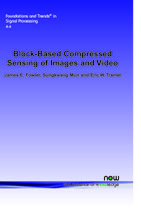Block-Based Compressed Sensing of Images and Video
By James E. Fowler, Department of Electrical & Computer Engineering, Geosystems Research Institute, Mississippi State University, USA, fowler@ece.msstate.edu | Sungkwang Mun, Department of Electrical & Computer Engineering, Geosystems Research Institute, Mississippi State University, USA, sm655@msstate.edu | Eric W. Tramel, Department of Electrical & Computer Engineering, Geosystems Research Institute, Mississippi State University, USA, ewt16@msstate.edu
Abstract
A number of techniques for the compressed sensing of imagery are surveyed. Various imaging media are considered, including still images, motion video, as well as multiview image sets and multiview video. A particular emphasis is placed on block-based compressed sensing due to its advantages in terms of both lightweight reconstruction complexity as well as a reduced memory burden for the random-projection measurement operator. For multiple-image scenarios, including video and multiview imagery, motion and disparity compensation is employed to exploit frame-to-frame redundancies due to object motion and parallax, resulting in residual frames which are more compressible and thus more easily reconstructed from compressed-sensing measurements. Extensive experimental comparisons evaluate various prominent reconstruction algorithms for still-image, motion-video, and multiview scenarios in terms of both reconstruction quality as well as computational complexity.
Block-Based Compressed Sensing of Images and Video
Block-Based Compressed Sensing of Images and Video overviews the emerging concept of compressed sensing (CS) with a particular focus on recent proposals for its use with a variety of imaging media, including still images, motion video, as well as multiview images and video. Throughout, it considers a variety of CS reconstruction techniques proposed in recent literature and examines relative performance of several prominent reconstruction algorithms for each of the various imagery formats. Particular emphasis is placed on block-based measurement and reconstruction which has the advantages of significantly reduced memory and computation with respect to other approaches relying on full-frame CS measurement operators. Block-Based Compressed Sensing of Images and Video employs extensive experimental comparisons to evaluate various prominent reconstruction algorithms for still-image, motion-video, and multiview scenarios in terms of both reconstruction quality as well as computational complexity. It is not intended to serve as an indepth tutorial on the theory or mathematics of compressed sensing. The coverage of CS theory is brief, while the specifics of the application of block-based compressed sensing (BCS) to natural imagery consume the bulk of the discussion.
